When the first diamond frame bicycles became popular in the 1890s they were often called "wheels" - the national cycling association was called the "League of American Wheelmen." We have moved from "wheels" to "bikes," but the bicycles have remained remarkably the same over more than 100 years - elegant in their efficiency and simplicity. And many of the issues that we think are new? They were around then too.
Showing posts with label France. Show all posts
Showing posts with label France. Show all posts
Saturday, January 6, 2018
A Great Cycling Comedy? Jour de Fête
Trailer-like video for the re-release of a restored version of this 1948 movie in 2014 - embedded video starts where cycling is featured
Jacques Tati was a film director and actor in France after World War II up through the early 1960s. His films are quite remarkable, making certain social commentary in films that were mostly physical and visual humor (although it is more complex than that).
His first 1949 full length film, Jour de fête (or The Big Day), centers on a postman in a French village who spends much of the film making deliveries (although I have only seen snippets, not the entire thing). Wikipedia has a short summary of the plot. Apparently the thought was he should perform more like the (then) super-efficient United States Post Office.
Two minute clip where the postman joins French racing cyclists on the road
It is not clear to me in the above scenes how he manages to appear to maintain such a high rate of speed; perhaps the playback is sped up somehow, although it doesn't look that way when he is with the other riders. Sitting bolt upright as he is, it would be hard to maintain such speed, particularly given what seems to be a single-speed bike and how it appears to be geared.
The postman chases his bicycle that travels a considerable distance without a rider
Again, I don't know how they did this - keeping the bike rolling for these distances without falling over. I like that the pedals keeping going around, as they would on a fixed gear bike.
Sunday, August 11, 2013
Guides du cycliste en France: de Paris à Toulouse et aux Pyrénees (1895)
The Internet Archive text archive (mostly books) has a great deal of interesting material, mostly published during the early 20th and late 19th century, but the assignment of subject keywords is not entirely regularized - one often finds surprising gems by trying different things. "Bicycle touring" for example returns only 18 hits - some of the items are advice about how to (do bicycle touring) while others are about particular bicycle tour experiences, although clearly most books in the later category have not been assigned this subject keyword pair (since there would be far more hits).
Among those 18 items I found this French guide from 1895 - Guides du cycliste en France: de Paris à Toulouse et aux Pyrénees published in 1895. My French is fairly poor but I can get a sense of what is being discussed (usually).
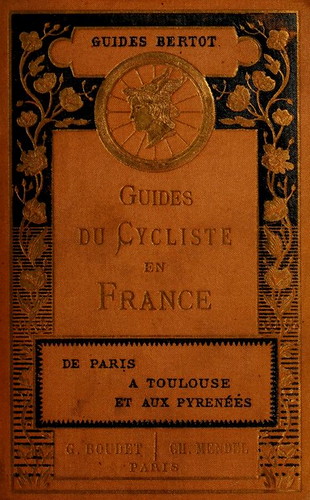
The well-preserved cover of Guides du cycliste en France ... from Boston Public Library
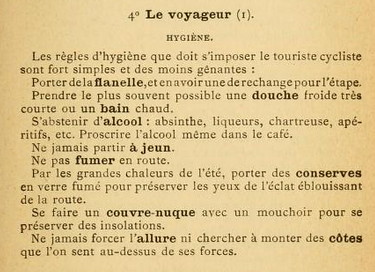
Advice on Hygiène
Google Translate renders this thus:
While there is a certain fractured nature to Google's rendering, generally it is clear enough. The exact advice might be updated in various ways but the issues remain, not surprisingly, the same.
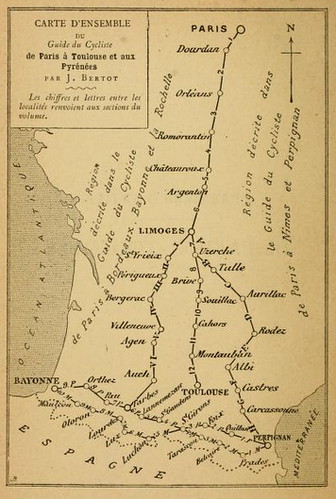
Map of the region of France relevant to this guide
Among those 18 items I found this French guide from 1895 - Guides du cycliste en France: de Paris à Toulouse et aux Pyrénees published in 1895. My French is fairly poor but I can get a sense of what is being discussed (usually).

The well-preserved cover of Guides du cycliste en France ... from Boston Public Library

Advice on Hygiène
Le voyageur
Hygiène
Les règles d'hygiène que doit s'imposer le touriste cycliste sont fort simples et des moins gênantes; Porter de là flanelle, et en avoir une de rechange pour l'étape. Prendre le plus souvent possible une douche froide très courte ou un bain chaud.
S'abstenir d'alcool : absinthe, liqueurs, chartreuse, apéritifs, etc. Proscrire l'alcool même dans le café.
Ne jamais partir à, jeun. Ne pas fumer en route.
Par les grandes chaleurs de l'étc, porter des conserves en verre fumé pour préserver les yeux de l'éclat éblouissant de la route.
Se faire un couvre-nuque avec un mouchoir pour se préserver des insolations.
Ne jamais forcer l'allure ni chercher à monter des côtes que l'on sent au-dessus de ses forces.
Google Translate renders this thus:
Hygiene rules should impose cycling tourists are very simple and less intrusive; Wear flannel there, and have a spare for the stage. Take as much as possible a very short cold shower or a hot bath.
Abstain from alcohol: absinthe, liqueurs, chartreuse, cocktails, etc.. Outlawing alcohol even in coffee.
Never leave an empty stomach. Do not smoke while driving.
By the great heat of étc, wear canned smoked glass to protect the eyes from the blinding light of the road.
Getting a neck guard with a handkerchief to protect against sunburn.
Never force the pace or trying to climb hills that we feel over its forces.
While there is a certain fractured nature to Google's rendering, generally it is clear enough. The exact advice might be updated in various ways but the issues remain, not surprisingly, the same.

Map of the region of France relevant to this guide
Wednesday, March 6, 2013
Bordeaux-Paris Winner 1896 and Simpson Chain
The Jules Beau photo albums have wonderful photographs of cycling from the 1890s and intot he next decade. Here is link to volume 3 for 1896. Below is one of the photographs from it.

Arthur Linton, who tied for the victory in the 1896 Bordeaux-Paris race
Title : [Collection Jules Beau. Photographie sportive] : T. 3. Année 1896 / Jules Beau
Author : Beau, Jules (1864-1932). Photographe
Date of publication : 1896
Subject : Sports -- France -- 1870-1914
Subject : Cyclisme
Mr. Linton from Wales tied the race that year and was given flowers, according to what is in the album, from the Gladiator factory. This is another image that shows the Simpson bicycle chain that I discussed in a previous blog post.

Arthur Linton, who tied for the victory in the 1896 Bordeaux-Paris race
Title : [Collection Jules Beau. Photographie sportive] : T. 3. Année 1896 / Jules Beau
Author : Beau, Jules (1864-1932). Photographe
Date of publication : 1896
Subject : Sports -- France -- 1870-1914
Subject : Cyclisme
Mr. Linton from Wales tied the race that year and was given flowers, according to what is in the album, from the Gladiator factory. This is another image that shows the Simpson bicycle chain that I discussed in a previous blog post.
Monday, March 4, 2013
Simpson Chain Shown on Gallica - 1896 Innovation
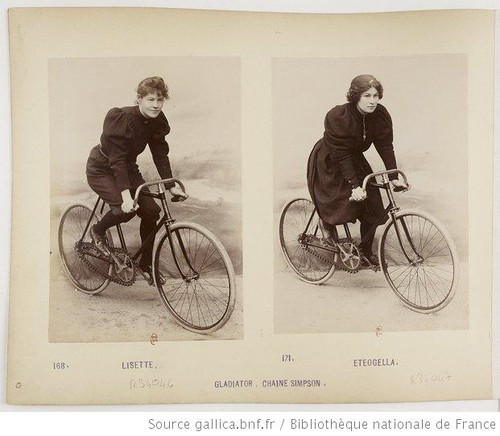
Two women riders, Lisette and Eteogella, riding bikes with "Chaîne à levier Simpson"
In this photo album with mostly photographs of then-famous French and other cycling racers there is this page with two photographs of women on bicycles (or more likely, what is one bicycle, a Gladiator) equipped with a "Simpson chain", which was considered a way of gaining a slight mechanical advantage over a traditional chain (that is a chain fundamentally the same as what we use today).
The chain consisted of a series of metal triangles with pins at the corners (see this illustration) so that along the inside it was much like an extended version of a present day chain (with the pins a bit further apart). Each link was matched by two other links extending out to a third pin. In the front the force was transferred the same as a bicycle today with teeth into the inside links, but at the rear the force was transferred by the pins on the outside edge. It gave the bikes that used them a distinctive appearance since the chain stood out.
Apparently there were match races to prove the superiority of this chain but ultimately not enough were convinced and people with some engineering experience decided that there was in fact no mechanical advantage to this chain. Certainly it added to the complexity of the drive train of the bikes that used it and to some extent the weight. There don't seem to be lots of photographs of this chain on the Internet on bikes, and although these are somewhat low resolution, they show it reasonably well.
Saturday, February 23, 2013
Finding Lucien Lesna, French Cyclist
I browse bicycle-related items in the Library of Congress Prints & Photographs Online Catalog (PPOC) from time to time. Sometimes it is not that easy, given the descriptive metadata provided, to understand what or who some photographs are.
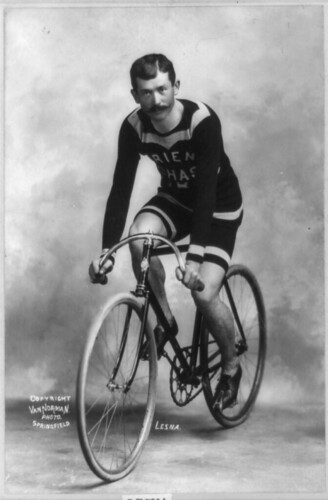
Identified in this Copyright deposit simply as "Lesna"
I happened upon this photo that came to the Library originally as a copyright deposit, presumably from the photographer's studio ("Van Norman Studio" that is applied to the photo). The only description that the Prints & Photographers had was his name, Lesna, which they did work out was his name.
Here is the minimalistic but better-than-nothing descriptive portion of record in PPOC:
Title: Lesna / Van Norman.
Creator(s): Van Norman, George H., photographer
Date Created/Published: c1898.
Medium: 1 photographic print.
Summary: Lesna on bicycle.
Now before I move on to what else I learned about Mr. Lesna (and how I learned it), a comment about this image. In the record, it says: Reproduction Number : LC-USZ62-99752 (b&w film copy neg.) What this means is that this image was not produced from the original photograph that was deposited at the Library of Congress but that at some point (decades ago, most likely) someone paid to have a copy made of that photograph for which there is a "b&w film copy neg."[ative] and that negative was digitized. This is a reproduction of a copy, not the original.
Also, the only JPEG provided on the Library of Congress site is a not-terribly-good 37 kb version - if you look at it closely, there are haloing artifacts and general mushiness. This was done years ago when smaller JPEGs seemed like a good idea for speedy delivery. If you look at the JPEG I produced with IrfanView from the TIFF that is also available on the LC site, it also has some mushiness issues (likely reflecting the copy negative and not the original) but you can certainly make out more detail. The smaller version embedded in this page looks nicely sharp compared to the slightly larger (in height/width in pixels) 37 kb LC version. So . . . it may be worthwhile if you want to look at details to use the TIFF (or create your own derivative) and not rely on the LC JPEG. But with a digital reproduction of a photographic reproduction you are only going to get so much detail in any event.
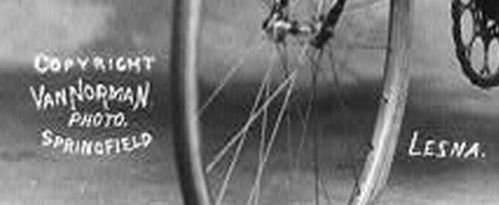
Haloing in LC JPEG visible around writing and spokes
So, knowing only that this was someone named Lesna who was in one of many towns named Springfield in the U.S. around 1898, how did I learn more? Like any sensible person, I started with Wikipedia. Simply searching "Lesna" brings up various towns - "Lesna" means "spring" (the season) in several Slavic languages and apparently is used for a town name. Searching "lesna cyclist" locates articles about several French bicycle races from the right time period where someone named "Lucien Lesna" won, for example Bordeaux-Paris in 1901. Alas Lucien Lesna has no article in Wikipedia - or rather, in the English Wikipedia. But in the French version there is a short article listing some of his victories (but no biographic info). And it has the same photo from LC. (The person who put it into Wikicommons also decided the LC JPEG was crummy and he or she produced a JPEG about the same size as the one I ended up with. Ha.)
With this knowledge that Lesna was a French cyclist, how did he come to be photographed in one of the many Springfields? Presumably he was on a racing tour of America. And in fact, a search of Chronicling America brings up this page with this headline: "MORE RECORDS SMASHED Michael Defeats Lesna in the Great Twenty-Mile Race. The Frenchman Makes a Gallant Fight" that is datelined "Springfield, Mass." September 16, 1897. (So apparently the photographer only deposited at LC the following year.)
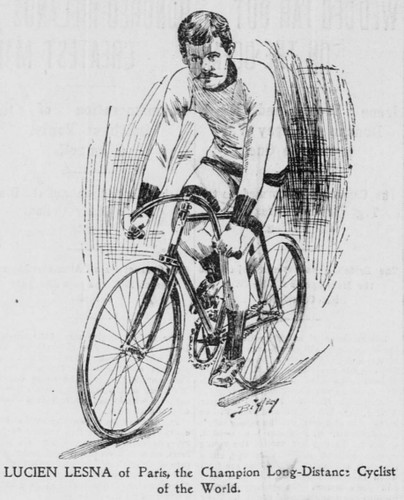
Illustration for article in San Francisco Call about Lesna
Another article in the The San Francisco Call from June 4, 1897 describes his arrival in America from Australia.

Identified in this Copyright deposit simply as "Lesna"
I happened upon this photo that came to the Library originally as a copyright deposit, presumably from the photographer's studio ("Van Norman Studio" that is applied to the photo). The only description that the Prints & Photographers had was his name, Lesna, which they did work out was his name.
Here is the minimalistic but better-than-nothing descriptive portion of record in PPOC:
Title: Lesna / Van Norman.
Creator(s): Van Norman, George H., photographer
Date Created/Published: c1898.
Medium: 1 photographic print.
Summary: Lesna on bicycle.
Now before I move on to what else I learned about Mr. Lesna (and how I learned it), a comment about this image. In the record, it says: Reproduction Number : LC-USZ62-99752 (b&w film copy neg.) What this means is that this image was not produced from the original photograph that was deposited at the Library of Congress but that at some point (decades ago, most likely) someone paid to have a copy made of that photograph for which there is a "b&w film copy neg."[ative] and that negative was digitized. This is a reproduction of a copy, not the original.
Also, the only JPEG provided on the Library of Congress site is a not-terribly-good 37 kb version - if you look at it closely, there are haloing artifacts and general mushiness. This was done years ago when smaller JPEGs seemed like a good idea for speedy delivery. If you look at the JPEG I produced with IrfanView from the TIFF that is also available on the LC site, it also has some mushiness issues (likely reflecting the copy negative and not the original) but you can certainly make out more detail. The smaller version embedded in this page looks nicely sharp compared to the slightly larger (in height/width in pixels) 37 kb LC version. So . . . it may be worthwhile if you want to look at details to use the TIFF (or create your own derivative) and not rely on the LC JPEG. But with a digital reproduction of a photographic reproduction you are only going to get so much detail in any event.

Haloing in LC JPEG visible around writing and spokes
So, knowing only that this was someone named Lesna who was in one of many towns named Springfield in the U.S. around 1898, how did I learn more? Like any sensible person, I started with Wikipedia. Simply searching "Lesna" brings up various towns - "Lesna" means "spring" (the season) in several Slavic languages and apparently is used for a town name. Searching "lesna cyclist" locates articles about several French bicycle races from the right time period where someone named "Lucien Lesna" won, for example Bordeaux-Paris in 1901. Alas Lucien Lesna has no article in Wikipedia - or rather, in the English Wikipedia. But in the French version there is a short article listing some of his victories (but no biographic info). And it has the same photo from LC. (The person who put it into Wikicommons also decided the LC JPEG was crummy and he or she produced a JPEG about the same size as the one I ended up with. Ha.)
With this knowledge that Lesna was a French cyclist, how did he come to be photographed in one of the many Springfields? Presumably he was on a racing tour of America. And in fact, a search of Chronicling America brings up this page with this headline: "MORE RECORDS SMASHED Michael Defeats Lesna in the Great Twenty-Mile Race. The Frenchman Makes a Gallant Fight" that is datelined "Springfield, Mass." September 16, 1897. (So apparently the photographer only deposited at LC the following year.)
Fifteen thousand people howled Jimmie Michael, the Welsh wonder, around the track at the bicycle races this afternoon for twenty miles until he finished over an eighth of a mile ahead of his rival, Lucian Lesna, and established a world's record for sixteen miles and upwards. The contest was a beautiful exhibition of bicycle riding and Michael's superior pacing and fine head work contributed to his victory.

Illustration for article in San Francisco Call about Lesna
Another article in the The San Francisco Call from June 4, 1897 describes his arrival in America from Australia.
LUCIEN LESNA, CHAMPION CYCLER - He Is the Greatest Long Distance Rider in the World. Arrived Here Yesterday From a Successful Pilgrimage to Australia. Can Ride Twenty Miles at a Two Minute Gait,and Now Holds All Australian Records - Lucien Lesna, the champion cyclist of France and also the champion long-distance rider of the world, arrived here yesterday morning on the steamer Mariposa from Australia and is stopping at the Palace.Thanks in part to Mr. Lesna's uncommon name and in part to the large amount of newspaper content digitized and searchable, it is possible to find out rather a lot!
Friday, November 30, 2012
Checking Out a Bike
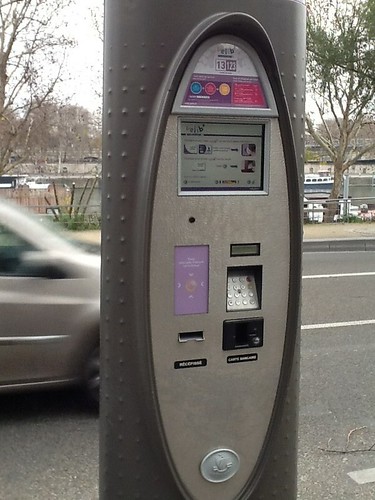
In front of the BnF
Since I have a short term user account with Velibe for using bikes for a week, I just have a subscriber number and pin and have to interact with one of these stations each time I get a bike. Fortunately they have an English option. Also, this one has a different interface than the first ones I used which confused me a little.
Wednesday, November 28, 2012
Velibe Bikeshare Station at BnF
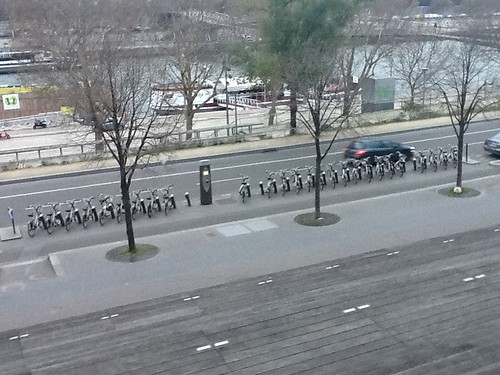
Velibe station, looking down stairs that form the side of the BnF
This is where I drop off my Velibe bike in the morning and pick one up when the workshops are over at the end of the day. So far there are always bikes there. In the morning sometimes the slots are all full! Then there is another station just a few hundred yards (meters) down the same road so I can go down there and it seems to be much less popular so there are more empty slots to drop off a bike.
The Velibe station is between the roadway and a dedicated bike lane that runs left to right (in this image). There is a no bike lane in the opposite direction although there is a lane for cars in that direction, which seems odd to me. Two car lanes and a bike lane in one direction and only one car lane in the other direction. I have seen some bikes going in that direction on the roadway, but some ride down below closer to the river on a path there. I have noticed this a lot - people choose different ways to go the same direction on their bikes. So far as I can tell, the drivers seem not to expect cyclists to stay off the road just because the cyclist has an alternative route away from the road.
When I check a bike out of the BnF station, I have to look back that no cyclist is coming up the bike lane since you back the bike out of its "docking station."
I now appreciate more a well maintained bicycle. The bike I rode back to the hotel today had a broken spoke or something - the rear wheel was quite out of round. Since these bikes have a coaster brake for the the back wheel, it didn't affect braking but it made the ride a little wonky. Others have had different "issues." None have been so much that I turn the bike in to get another one, though. I do check that a bike has air in the tires first but more than that while it is locked up isn't possible.
Tuesday, November 27, 2012
Tuesday, April 24, 2012
French Chainless Bike, 1890s Poster

My terrible effort pasting together two halves of a scanned poster
Another follow-up on the shaft drive bike-share bikes in Los Angeles - they have been around forever, so if there was something so great about shaft-drive bikes, we'd have a few more being made today.
This poster is for a French bike from the late 1890s and pushes the chainless aspect - it isn't so much pro-shaft drive as anti-chain.
Title: Acatène Velleda / / L. Baylac, Biarritz '98.
Creator(s): Baylac, Lucien, 1851-1913, artist
Date Created/Published: Paris : Imp. Kossuth & Cie., 1898.
Medium: 1 print (poster) : lithograph, color ; 156 x 118 cm.
Summary: Advertising poster for the chainless Acatène Metropole bicycle with G&J tires showing the Germanic priestess, Velleda, a legendary leader of the Batavian uprising against the Romans, with a bird of prey carrying chains and the Latin motto "Vae Catenis," or "Woe to Chains," above its head.
From the Library of Congress
Persistent link to full record
In the good old days of digitization, a large-ish poster like this was scanned in two pieces and the two parts offered up separately, leaving it to others to piece them together. The images are skewed and I could have probably done this better if I fiddled with it, but this is a lot better than what you see here.
The LA shaft-drive bikes have a chain stay (well, what else do you call it, even if it is a chainless bike??) plus the shaft drive, but this older bike follows the more "elegant" design of replacing the right side chain stay with the shaft drive shaft. So, you have to give the old time bike designers credit for that.
Subscribe to:
Comments (Atom)
